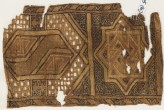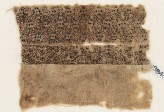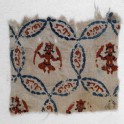Newberry Collection
Explore Percy and Essie Newberry's important collection of textiles including Islamic embroideries and Indian block-printed fragments.

The Newberrys’ interest in embroidery is evidenced by their large collection of embroideries and samplers from various regions of North Africa, the Middle East, and Europe.
Range of embroideries
1010 Islamic embroideries from medieval Egypt, dating from the Fatimid (AD 969-1171), Ayyubid (1172-1249), and Mamluk (1250-1516) periods, were given to the Ashmolean Museum, together with their Indian printed cottons. These embroidered textiles are mostly fragmentary, but remains of seams and hems indicate that they were once used for both garments (shawl, sashes, tunics) and furnishings (cushion covers, wall hangings). Forty-eight pieces have been carbon dated.
Embroidery techniques and decoration
Generally, the ground fabric is undyed linen, often of fine quality, with the embroidery stitched in silk thread. A few pieces have a cotton ground, and cotton and flax have occasionally been used for the embroidered patterns as well. More than twenty-five different stitch techniques were used, with many of them counted and worked with great precision to produce extremely fine and intricate patterns. A large number of pieces have geometric patterns.
 Textile fragment, possibly from a sash or shawl (EA1984.445.a)
Textile fragment, possibly from a sash or shawl (EA1984.445.a)
 Textile fragment with star and pseudo-inscription (EA1993.357)
Textile fragment with star and pseudo-inscription (EA1993.357)
 Textile fragment with band of stars (EA1984.472)
Textile fragment with band of stars (EA1984.472)
Vegetal patterns, figurative motifs, and calligraphy feature on some of the textiles as well. A small number of pieces in the collection are made of tiraz (fabric with an embroidered or woven inscription band), some of which have information about dating and provenance in the embroidery itself.
 Textile fragment with quatrefoils and interlacing kufic script (EA1984.108)
Textile fragment with quatrefoils and interlacing kufic script (EA1984.108)
 Textile fragment with tiraz band (EA1988.48)
Textile fragment with tiraz band (EA1988.48)
 Textile fragment with Jupiter in Pisces or Mercury in Virgo (EA1984.76)
Textile fragment with Jupiter in Pisces or Mercury in Virgo (EA1984.76)
The use of embroidered textiles
The high quality of many of the pieces indicates that they were made for a fairly wealthy, middle-class clientele. However, the use of heraldic emblems on several fragments identifies some owners as members of the court - blazons, for example, were attached to Mamluk official’s garments as signs of rank.
It is interesting to note that these embroidered fabrics were manufactured and used in Egypt at the same time that printed cottons were imported from India. It is possible that these very different textiles were appreciated, bought, and used by the same people.
© 2013 University of Oxford - Ashmolean Museum


